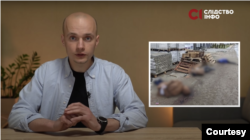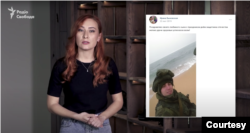Before the Russian invasion, Ukrainian journalist Dmitry Replyanchuk spent his days unearthing corruption, often among judges and law enforcement.
Now the Kyiv-based journalist who works for the independent media website Slidstvo.Info uses his investigative reporting skills to expose war crimes and atrocities.
Every crime has a face, Replyanchuk told VOA.
“War criminals who executed civilians in Bucha, pilots who dropped bombs on Mariupol and other Ukrainian cities, artillerymen who shelled Kharkiv: those are specific people,” he said. “And my job is to reveal these people.”
With the first Russian soldier standing trial for war crimes this week, and journalists interviewing residents of cities besieged or occupied for weeks, Ukraine’s media has played an important role in documenting and collecting evidence.
In recognition of their efforts, the U.S. Pulitzer board awarded a special citation in May to Ukrainian journalists for their “courage, endurance, and commitment to truthful reporting” in covering the war.
For the country’s journalists, they have one objective: Ensuring the world knows the names of all those involved in atrocities in Ukraine.
Using open source intelligence or OSINT methods, searching satellite images and social media, and interviewing witnesses, journalists have been able to identify specific soldiers who killed and tortured civilians in Bucha, and shed light on what is happening in Mariupol.
Replyanchuk, whose outlet is part of the Organized Crime and Corruption Reporting Network uses open data to investigate.
Together with his colleagues, the journalist analyzes lists of Russian units published by Ukrainian intelligence and searches Russian social networks Vkontakte and Odnoklassniki for military profiles.
Some of the soldiers, especially those who are younger, are also active on TikTok. In some cases, said Replyanchuk, soldiers brag of torturing civilians.
“There’s no need of interrogating anyone. They publish those things themselves. They boast of this in their social media,” said Replyanchuk.
After analyzing hundreds of such profiles, he came to another conclusion.
“Based on what I see, the vast majority of Russians support the war against Ukraine and call to continue it. This is definitely not only Putin's war against Ukraine, this is the war of Russia and the Russian people,” he said.
Polls by the independent Russia-based Leveda Center show backing among Russians for their troops in Ukraine, but that support is dropping. Most of those polled believe the U.S and NATO are to blame for civilian casualties.
Valeria Yehoshyna, a journalist at Skhemy—or Schemes, an investigative news project run by Radio Free Europe/Radio Liberty (RFE/RL)—says that since the beginning of the invasion, she has mastered new skills for working with data.
RFE/RL and VOA are both independent networks under the Congress-funded U.S. Agency for Global Media.
“We got access to services that help with satellite imagery. This is a fairly new field for us, but I believe that we are working quite successfully,” Yehoshyna said. “For instance, we are able to show the redeployment of Russian equipment.”
The imagery also helped her team find mass graves in the villages of Mangush and Vynohradne near Mariupol.
The grave in Mangush was 300 meters (over 980 feet) long, says Yegoshyna. The one in Bucha was 14 meters (almost 46 feet) long and contained 70 bodies.
But the most startling discovery was an intercepted telephone conversation between two Russians. The recording, a call between a woman and a man, was released by the Security Service of Ukraine.
In it, a woman is heard telling her partner in Russian that he can rape Ukrainian women as long as he doesn’t tell her the details and uses contraceptives.
The recording shocked Yehoshyna.
“The woman on that audio not only allowed her husband to rape Ukrainian women, but she also seemed to encourage him to do so,” she said.
Together with her colleagues, Yehoshyna traced the people on the call.
“From our sources in law enforcement, we were able to obtain two Russian telephone numbers who participated in that conversation,” Yehoshyna said. “Then with the help of our colleagues from the Russian service of Radio Free Europe, we found the accounts on the Russian social network Vkontakte to which those numbers were linked. So we found their pages, their relatives, their friends. Plus, we called them, and the voices on the audio also matched completely.”
Identifying members of the Russian military also helps official investigations, said Yehoshyna. Before the war, Ukrainian law enforcement were sometimes a subject of journalists' investigations. Today, they find ways to collaborate.
The Prosecutor General's Office of Ukraine has named suspects believed to have committed crimes in Bucha. Information collected by the Slidstvo.Info team was used to identify one of them.
“We find victims and witnesses, and we work with them to establish the identity and details of specific Russian occupiers who either killed or were involved in torturing or in taking civilians hostage,” said Replyanchuk.
Together with his colleagues, he managed to identify a number of Russian servicemen, collecting evidence like a puzzle, based on testimonies of witnesses.
“Someone remembers the name. Someone remembers the military rank, someone remembers something else,” Replyanchuk said.
From there the team goes to work, recording the evidence and searching open data and social media to identify the people.
For Yehoshyna and many journalists in Ukraine, this war is different from others.
“In this war, we can capture almost everything that happens,” Yehoshyna said.
“Satellite imagery, social media, intercepted calls, all of this helps us. Even people in the temporarily occupied cities take videos and photos and then publish them. There has never been a war with so much [digital] evidence, I'm sure.”
Investigative journalists hope that the testimonies and work will serve two purposes: Evidence for an international tribunal and to act as a record, so that no one can falsify history.










